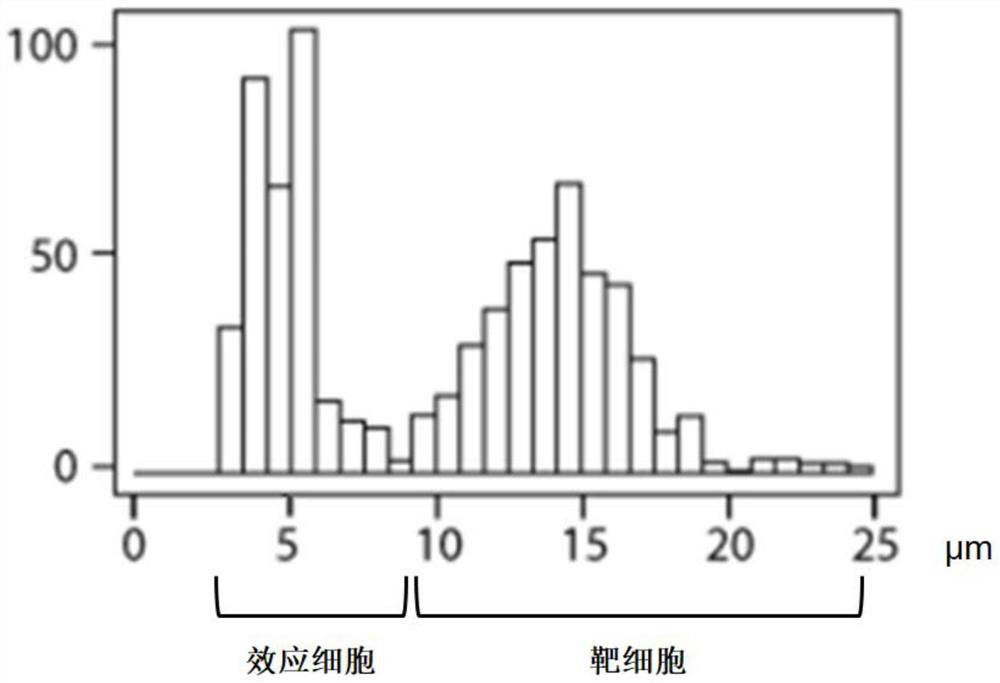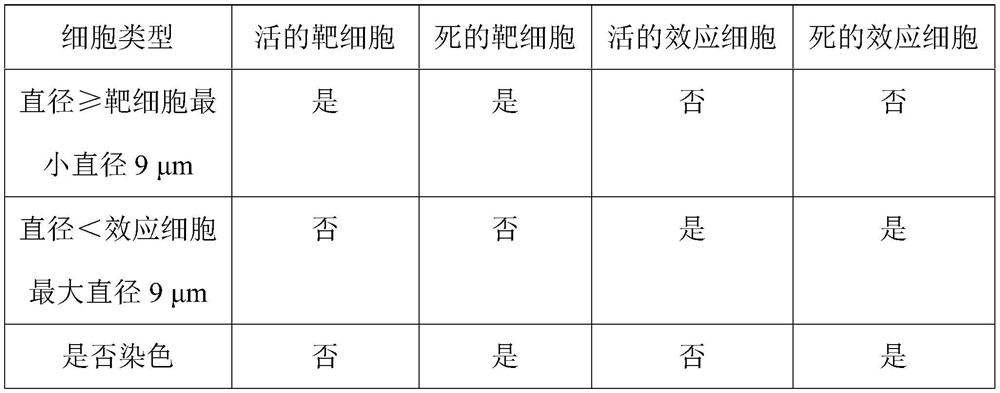Method for evaluating cell killing efficacy based on cell diameter and application thereof
A cell and potency technology, applied in the field of cell killing potency detection, can solve the problems of inability to collect cell images and reduce the repeatability of experimental results, and achieve the effects of intuitive and accurate results, simple operation and high application value.
- Summary
- Abstract
- Description
- Claims
- Application Information
AI Technical Summary
Problems solved by technology
Method used
Image
Examples
Embodiment 1
[0064] This example provides a method for evaluating cell killing efficacy based on cell diameter.
[0065] Described method specifically comprises the steps:
[0066] (1) Prepare effector cells as effector cell suspension, the maximum diameter of the effector cells is 9 μm;
[0067] (2) Collect tumor cells, prepare target cell suspension, the minimum diameter of the target cells is 9 μm, and transfer to 96-well plate;
[0068] (3) Set the effector-target ratio to 1:1, and add the effector cell suspension into the 96-well plate that already has the target cell suspension;
[0069] (4) After 24 hours of co-cultivation, remove the supernatant, wash with PBS buffer, add 0.25% trypsin to digest the adherent cells, centrifuge, resuspend, and adjust the cell density to 1×10 6 / ml.;
[0070] (5) After mixing the cell suspension with 0.2% trypan blue solution at a volume ratio of 1:1, pipette 20 μL to the counting plate and place it in the detection instrument (the instrument used ...
Embodiment 2
[0084] This example provides a method for evaluating cell killing efficacy based on cell diameter.
[0085] Described method specifically comprises the steps:
[0086] (1) Prepare effector cells as effector cell suspension, the maximum diameter of the effector cells is 9 μm;
[0087] (2) Collect tumor cells, prepare target cell suspension, the minimum diameter of the target cells is 9 μm, and transfer to 96-well plate;
[0088] (3) Set the effector-target ratio to 1:1, and add the effector cell suspension into the 96-well plate that already has the target cell suspension;
[0089] Prepare the control group cells at the same time: add only the target cells and the medium to the culture dish as the target cell control group, and add only the effector cells and the medium to another culture dish as the effector cell control group;
[0090] The above-mentioned control group and experimental group are placed under the cultivation environment and cultivated;
[0091] (4) After 24...
Embodiment 3
[0112] Compared with Example 2, in this example, different effect-to-target ratios (E:T) were set as experimental groups to measure the killing efficacy of cells under different effect-to-target ratios.
[0113] The working concentration of effector cells was adjusted, and the effect-to-target ratio was set to 10:1, 5:1 and 1:1, and the remaining steps and experimental conditions were kept the same as in Example 2.
[0114] The obtained experimental results can determine the best effect-to-target ratio and provide a basis for further screening or optimization. To sum up, the method provided by the present invention is relatively intuitive, and can directly obtain visualized cell fluorescence images, obtain different states of cells based on microscopic images, and then analyze the killing efficacy of immune cells. The method has simple steps and improves detection efficiency and accuracy.
PUM
| Property | Measurement | Unit |
|---|---|---|
| The maximum diameter | aaaaa | aaaaa |
Abstract
Description
Claims
Application Information
 Login to View More
Login to View More - Generate Ideas
- Intellectual Property
- Life Sciences
- Materials
- Tech Scout
- Unparalleled Data Quality
- Higher Quality Content
- 60% Fewer Hallucinations
Browse by: Latest US Patents, China's latest patents, Technical Efficacy Thesaurus, Application Domain, Technology Topic, Popular Technical Reports.
© 2025 PatSnap. All rights reserved.Legal|Privacy policy|Modern Slavery Act Transparency Statement|Sitemap|About US| Contact US: help@patsnap.com



